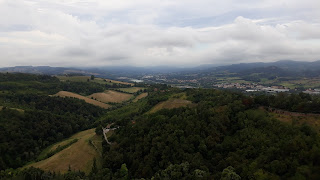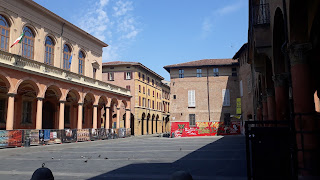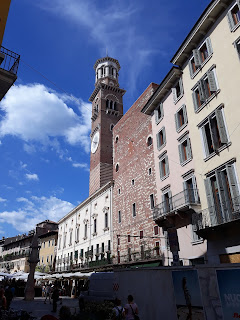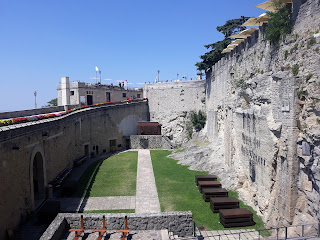Another foray into a part of the country I am not familiar
with, Lincolnshire, uncovered another layer of our great country. I camped on a
lovely site, the Camper UK Leisure Park, just inside the Lincolnshire border
and a few miles outside the grand old town of Lincoln. It had a well-tended
core with a lake surrounded by chalets, a kitchen and games room, plots for
motorhomes and a vast outlying field for overspill and tents like mine which
had the field virtually to myself. A short walk to the core gave access to a
row of clean, modern toilet and shower cubicles. Just don’t forget it’s
seriously flat and don’t those winds blow across these eastern English steppes,
so just prepare for that!
Driving up the A1 in this part of the country takes you past some English towns worth a serious stop like Newark on Trent and Stamford which you’d miss if you just carry on speeding up the A1. Newark was a revelation, with an impressive Civil War history and a fine town centre just a few miles from Newark show ground where I stayed for a few days. Newark has a lovely old town square with cobbled pavements and colourful market stalls, fronted by a classical town hall which boasts an old-fashioned indoor street with associated eateries and cosy enclosed passageway to the surrounding area. A large church sits just off the main square surrounded by gardens, trees and parkland, and a castle sits just down by the river. The town centre itself would give many British towns a run for their money.
I had never been to Lincoln, but camping nearby gave me the chance to nip into the centre virtually every day. It’s well worth a visit, even just for the cathedral, one of the biggest in the country. Although Lincolnshire is pretty flat, Lincoln itself is splayed over rolling countryside with the cathedral and its ancient Cathedral Quarter on a bluff commanding and overlooking the rest of the town. Of course the cathedral itself is the main attraction, with its huge twin towers dominating the frontage and surrounded by an open green oasis. Well worth a visit, there are a number of tours that cover the history, one of which, the Floor tour, takes you round the vast core of the inside of the building, whilst the Roof tour takes you around the roof areas and out onto the roof with great views of the vicinity including the castle across the road. Around the cathedral and down into the modern town centre is a wonderful medieval jumble of streets and buildings with plenty of cafes and restaurants to fuel your touristic wanderings, centring on the very steep Steep Hill which winds down to the modern shopping mecca and modern core.
Opposite
the cathedral at the other end of Castle Hill is the castle precinct in the
Bailgate area, comprising an oval of walls and associated infrastructure,
within which is a jumble of buildings, including the Crown Court, a Victorian
prison with male and female sections and a copy of Magna Carta which can all be
visited. An audio guide whilst on the wall and copious information points give
a comprehensive story of the history of the castle. The wall walk provides a
chance to drink in a 360 degree panorama of Lincoln itself. Prepare yourself
with the car parking. There is a series of car parks adjacent to the city
walls, but there are also some free spaces certainly in the evening along the
adjoining street. Incidentally there’s also a Park and Ride from Waitrose on
Searby Rd, Lincoln to avoid parking problems.
Sliding down Steep St takes you into the modern centre of
Lincoln and the Cultural Quarter with the usual mix of chain stores,
pedestrianised areas and old and new build. At the south end of the High St the
St Mark’s shopping centre stretches away in a medley of new developments built
round the remains of the old railway station. Not far from here is the Brayford
Waterfront, a rather unusual and attractive inland water feature, a bit like
having a lake in the middle of the city but actually a swollen part of the
River Witham. Its northern edge is actually packed with restaurants and
watering holes including old favourites like Wagamama which are stretched out
along the modern waterfront. From here you also get some great views of the
city skyline, especially up to the cathedral quarter.
Lincolnshire was called Bomber County in the war because of the presence of 49 military airfields, more than any other county in England, to support the endeavours of bomber command. So there are a lot of mementoes of the war scattered over the county including old airfields that can be visited. Just outside Lincoln to the south off the A15 and high on a hill is the International Bomber Command Centre, well worth a visit. Here at the huge open-air memorial is the Memorial Spire 31m tall, the wingspan of the Avro Lancaster, and the Walls on which are recorded the names of nearly 58000 men and women who gave their lives as members of bomber command, as well as Peace Gardens landscaped with plants and trees. There is a very worthwhile tour with knowledgeable guide on the history of the attraction, and it is the only place in the world that memorialises every loss in Bomber Command. There is also an exhibition, and a very nice modern café as well as a shop. Outside the front of the main building is a memorial to the airlift to feed the Dutch people at the end of the war who were suffering terrible famine.
Just down the road is RAF Waddington which has
a heritage centre on the history of the station. There is a viewing area on the
A15 overlooking the airfield together with snack bar and gift shop. Traversing
the county one just comes across one airfield after another. RAF Scampton on
the main road from Lincoln to Gainsborough was a famous bomber base and is the
home of the Red Arrows, although they are scheduled to move to RAF Waddington. Scampton
of course was the base for the 617 Dambuster squadron led by Wing Commander Guy
Gibson. The Heritage Centre covers the history of the base from the Great War. You
can immerse yourself in World War 2 history by visiting the Dambusters Inn,
just down the road from the air base. The western edge of Scampton airfield is
a natural lip that looks out over a vast swathe of countryside sweeping down over
the Trent valley, great place to admire the views.
Gainsborough is a small town in western Lincolnshire on the River Trent and is worth a visit to see Gainsborough Old Hall, a medieval Tudor Hall run by English Heritage. It sits just on the edge of the town centre a short walking distance from the river and provides an amazing contrast to the quiet residential streets that surround it. A giant of a building of the black and white timbered variety, it has a great hall, kitchens, former living quarters, battlements amongst other attractions. It must be one of the finest examples of its type in the country, and to think that they were planning to knock it down to build a car park in the fifties!
There is not much to see in the town centre which is pretty standard but there is a fine shopping centre, Marshall’s Yard, which has been constructed around the core of an old steel works and is tastefully designed in a rectangle of outlets around car parking, fountain and decorative features.
One thing I noticed looking at house prices
round here is that housing is pretty cheap compared with the South-East as I’m sure you realise! You could sell your house down south and
buy maybe two properties up here, live in one and rent the other out! The river
Trent provides a good opportunity for a riverside walk along the western side
of the town. I walked to the bridge at the southern end of the town and then took
the riverside walk all the way back to where my car was parked north of the
town centre.
I stopped off at Stamford on the way home for breakfast and
funnily enough had only visited the town a year previously in 2021. It must be
one of Lincolnshire’s, and indeed England’s, most attractive towns, bursting
with old world charm and listed buildings. Dress everyone in nineteenth century
costume and you would hardly be able to tell which age you were in, then or
now. You can spend a delightful hour or two just wandering the ancient centre
and pedestrianised streets, admiring the honey-coloured architecture which
reminds one of a Cotswolds town. There is plenty of shopping to be had and an
abundance of eateries and cafes to satisfy the most ardent foodies. I had
possibly the most expensive breakfast I have ever eaten, the full Monty but
with delectable mini tomatoes.
The town slopes down to a waterway with meadows beyond, a
great spot for a picnic or a sit down to admire the impossibly chocolate-box
vista. Even the railway station, a few minutes walk further, will delight
architectural fans. For Stamford, the icing on the cake is Burghley House, a
splendid Elizabethan mansion which sits in parkland within walking distance of
the town centre. This pile is well worth a visit even if you wander the
extensive grounds, what a place for a dog walk if you’re a local. Stamford
looks to be a lovely place to live.








































































